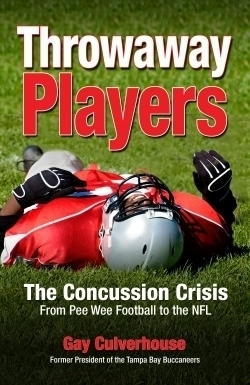
Throwaway Players
The Concussion Crisis, From Pee Wee Football to the NFL
In her book Throwaway Players: The Concussion Crisis, From Pee Wee Football to the NFL, former Tampa Bay Buccaneers President Gay Culverhouse reveals the dark side of football in America. Today’s fans see the six-figure contracts, the 20,000-square-foot mansions, and fast cars. They love the diving catches and bone shattering tackles, but are completely oblivious to the fact that the majority of retired players “are being fed to the lions of bankruptcy, arthritis, and dementia.” Culverhouse tells the fans what the National Football League does not want them to hear—the stark reality that for the majority of its existence, “the NFL didn’t care about their players once they were no longer on the field.”
Culverhouse, the founder and president of the nonprofit Gay Culverhouse Players’ Outreach Program, majored in special education in college, and is a researcher and diagnostician by training. Her book is based on her time spent as president of the Buccaneers, three years of medical research, excerpts from newspaper articles, interviews with leading neurologists, and the personal anecdotes of former players. Through this book, she seeks to raise awareness among fans and the league of what happens to NFL players once they leave the game. Her book is an essential read for athletes, coaches, parents, and football fans.
In Throwaway Players we learn that the average annual NFL salary is fewer than one million dollars, and that most of the money is not guaranteed. We also learn that the money vanishes as soon as a player is cut, retired, or leaves the team. We are informed that the average NFL career spans just four seasons, and that the majority of players are untrained for a second career. “Consider that a player has, in general, four years or less to make enough money for himself and his family to live on for the rest of his life,” writes Culverhouse.
From this perspective, Culverhouse hopes that fans, parents, and coaches will also become cognizant of the immense pressure placed on football players at all levels. From Pee Wee football to the pros, there is pressure to perform, to stay ahead of the competition, and to win. These pressures have led to players using steroids, keeping their concussions a secret, and playing through severe injuries.
In the end, the show goes on, but it’s the former players who pay the price for the mental and physical abuse suffered during their careers. These “throwaway players,” as Culverhouse calls them, have been exploited and then neglected by the league that brought them in and the fans that worshiped them.
Throwaway Players brings to light many of the most important issues the NFL is currently dealing with. The league is transforming before our very eyes as a result of people like Culverhouse. She wants the reader to know, however, that her main goal is not to kill the game, just to make it safer, and in turn, improve players’ health both during and after their careers. At times, Culverhouse lets her emotions get the best of her. However, as much as she is an idealist, she is also a realist—a realist who is well aware that football is, and always will be, a violent and dangerous sport.
Reviewed by
Andrew Kipp
Disclosure: This article is not an endorsement, but a review. The publisher of this book provided free copies of the book to have their book reviewed by a professional reviewer. No fee was paid by the publisher for this review. Foreword Reviews only recommends books that we love. Foreword Magazine, Inc. is disclosing this in accordance with the Federal Trade Commission’s 16 CFR, Part 255.
